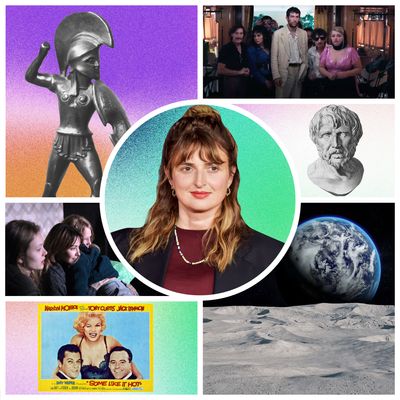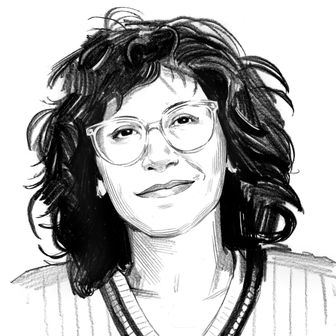
Alice Rohrwacher’s La Chimera has it all: a band of music-playing, charming grave robbers, two swooning romances, song breaks, a beat-up green car, and enough jokes and heartbreak to go around. The Italian filmmaker’s fourth narrative feature tells the story of Arthur (played with handsome ruefulness by Josh O’Connor), a somewhat magical ex-con with the ability to find Etruscan artifacts hidden in the Italian countryside. With a group of merry tombaroli, he goes digging — in search of wealth and art, sure, but also something deeper.
Rohrwacher’s films have a swooning, pastoral quality and a keen interest in Italian history. Prior to La Chimera she worked on a documentary about the Italian youth with filmmakers Pietro Marcello and Francesco Munzi called Futura, an “archive for future generations,” and before, her film Happy As Lazzaro won Best Screenplay at Cannes in 2018. (Her short film Le Pupille was nominated for an Academy Award in 2023.) Her work is pensive and off-kilter; it’s idiosyncratic and slowly revealing, eager to push the boundaries of what the viewer knows to be real. La Chimera is lush with blues and greens, at once mournful and joyous, and like a number of her films prior, its concern lies in society’s desire to prioritize systems of class and money over collectivism and love. She’s spoken about her inspirations, from Federico Fellini’s Roma to Indiana Jones, and here she digs into the humanist qualities that set her work apart.
La Chimera and other films of yours have gone on tour, so to speak, to various film festivals across the world. Have you had a favorite city or place on this particular tour?
When you present in Cannes, it’s really emotional, but also when I presented at the New York Film Festival, I was so curious to see the reaction because it’s a story that’s so connected to my region of Italy. It’s always surprising and mysterious to see how a story can talk to people from other parts of the world. I’m very happy that now, all over the world, everybody knows the word tombarolo, which is a grave-robber. Not even everyone in Italy knew that word!
After seeing La Chimera, I went to a museum and found myself first seeking out the Etruscan artifacts. I’m curious about when you go to a museum, how you decide what you might go look at first?
Generally, I look for the Etruscan art, because I know that tombaroli have claimed to have sold lots of relics and pieces, so I’m curious about that. What’s also fascinating to me is that in the past, what happened in the museum was that they would just put an object there and that was the appeal, the object per se, not its history, what was around it, what came with it. It was uprooted and just slapped there for everyone to see, and people didn’t really care that there wasn’t any storytelling connected to the object. Now, luckily, museum experiences have changed so that now when you want to see an item on display, you can know its context, where it came from, its story.
But there is one example that I have for you that is very telling. I would really love to see these statues of two Etruscan warriors that were actually made here in my town. I’ve even seen the underground kiln where they were made. They were sold to the Metropolitan Museum, but they were fake. They were not the real thing. They were just fake! When the Met realized what was happening, that they had illegally bought two statues that were fake, they were so ashamed, of course, that they decided to hide them in their basement, basically, and never talk about it ever again. So we have those two big warriors there that are hiding somewhere in the basement of the Metropolitan Museum. I would really love to see these statues because on the one hand, it’s a fun story because this was an object that was bought illegally to be shown, and then turned out to be fake. On the other hand, if you look at the images that you find online, you can see that it says a lot about what the people who made these statues thought Etruscan warriors looked like. The time has come to show them because they tell a very fascinating story that is … let’s say, scandalous, in a way, but then again, they have their own story.
Where do you get your best cultural recommendations from? Friends or other artists or …?
[Laughs.] From life, I would say!
Are there any three artists or celebrities you’d want to have dinner with, living or dead?
Well, I would love to have everybody! I cannot select! I’m open to anybody, I’m so curious, I’m like, everybody, come over! Life itself is a great source of inspiration in terms of how much humanity there is out there. I would say also that the source of this sort of dualism is that I am curious about the lively, energetic presence of all there is to know and to understand, and to get to know out there, but there’s also always something that is other, or that is distant from you. I look at people around me from the inside and from the outside at the same time, that’s how I work and how I see the world. I love to meet people, but I also love to look at people like I am trying to see them from the moon.
What are you watching or listening to as you work on a film?
We have a saying here that is like, when you’re pregnant, you start to notice that everyone else is pregnant. That’s kind of the same when I’m working on a film project, because basically what happens to me is I look around and everything seems to be talking about or referring back to my film. [Laughs. ]It’s astounding! It’s like a web of incredible coincidences that everything and everybody’s talking about exactly what my film is talking about. And I find that extremely exciting. It touches me deeply.
This thing about coincidences might be due to the fact that I am of Etruscan origin myself. Seneca, the Roman philosopher, expressed it very well when he said that there is a major difference between us — Romans and Etruscans. Why? Because basically, Romans think that lightning is caused by two clouds just crashing into each other. Etruscans, on the other hand, think exactly the opposite, that is to say, the two clouds deliberately crash into each other to make lightning.
Do you have a favorite comfort watch?
Some Like It Hot!
An amazing movie!
It’s so funny. I really love so many different movies, from the most commercial to the most poetic. It’s difficult for me to make a list.
What’s the best piece of advice you received, either about life or making films or both?
That goes back to my first film, Corpo Celeste, or Heavenly Body. I met a producer who’s no longer with us, Karl Baumgartner, who also went by Baumi. He was reading the script of my film and then we met. At the time when I met him, I was shy in a way, but I was young and I had my pride. I said something that I’d heard from other producers: “Well, I’m not sure if there’s a public out there that would like my movie. It’s so weird, so maybe I’m not sure they would like it.” He turned very serious at that point and said, “Who do you think you are?” which kind of threw me and I felt so bad all of a sudden, and I was like, Oh my God. He said, “Do you think you’re different? You’re actually exactly like all those people out there who are going to be watching your movie. Millions of people out there are exactly like you, and they’re gonna come and watch a movie.”
So the greatest piece of advice that he gave me was that you make a movie that you like and that you would like if you were in the audience, a member of the public, and all those people just like you will come and watch it and they will love it. You make a movie not because you feel different, but because you feel exactly the same as those people who will watch it.
This interview has been edited and condensed for clarity.


